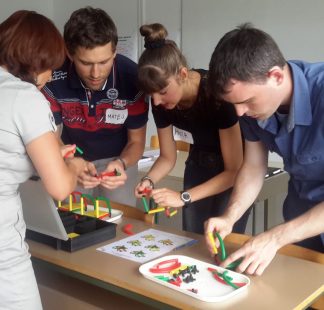What is the HP Stockless Production Video?
The famous HP video illustrates the major changes that were taking place during the 1980s in the development of manufacturing planning and control systems and is a good example of an early lean game. In fact, the modern MTa Kando Lean game, builds on some of the principles illustrated.
The first major change had been in the 1960s – the use of computer systems and the change from cabinets full of stock cards to the use of Material Requirements Planning (MRP1). In the USA, in the 60s and 70s, the innovators were Orlicky, Plossl and Wight, whilst Deming went to Japan to teach quality improvement techniques. The second major change, from the 1980s, was to Just in Time (JIT) and Lean Manufacturing.
Old paper-based stock control systems used card files to record stock issues, receipts and the stock balances with re-order levels, usually based on historic usage, to trigger the placing of new supply or new work orders. By contrast, MRP1 logic calculated the requirements and suggested orders at all levels in the product structure based on combinations of actual and forecast sales demand. It used the idea of standard factory lead times (assuming ‘infinite capacity’) to calculate when to release batches of work and when suppliers needed to deliver component requirements. As a result, MRP is considered to be a ‘push system’.
During the 70s, computer systems started to include capacity planning and shop-floor control and became known as Manufacturing Resource Planning (MRP2). Having calculated the material requirements, MRP2 systems included capacity requirements planning and the need to prioritise queues of work within departments or the batches awaiting machine availability.
In parallel with the MRP developments, Toyota were developing the Toyota Production Systems (TPS). Unlike MRP calculation systems, TPS also included quality considerations, the use of standard operating procedures plus continuous improvement (kaizen) and encouraged avoiding theory and studying where the work is actually done (gemba). The ideas spread to other automotive companies as well to aerospace and electronics companies.
Bill Hewett and Dave Packard started HP in the 1930 making instruments – working in a garage that has now become an HP Museum. The two main divisions were instruments (including medical equipment) and computers. Prior to PCs and computer servers, HP became a major supplier of mini computers (HP1000 and HP3000) at a time when IBM mainframes were dominant in larger companies.
By the early 80s, Japanese electronics companies could sell computer printers for less than the cost of making them in HP factories. Within HP, Stockless Production presentations became the key to making the transition from traditional manufacturing systems to pull systems – less stock and work in progress. The 1983 video compares cycle times, work in progress, space and the visibility of rework.
JIT is best suited to repetitive manufacturing and stable demand patterns. As such, forecasting the demand for components becomes easier and capacity planning of departments is replaced by production lines (or work stations) and manufacturing cells. Capacity planning now involves arranging tasks so that all work loads are balanced to average demand (takt time). Suppliers know their overall components and are able to supply replacement components on demand as needed (kanbans).
During the 90s, JIT became the dominant fashion whilst software companies promoted Enterprise Requirements Systems (ERP) that included MRP logic as well as accounting, purchasing and sales functionality.
In the UK, Dan Jones and John Bicheno were notable advocates of Lean Manufacturing. The book ‘The Lean Toolbox’ provides an important reference collection of Lean techniques.
The 1983 HP video triggered several experiential learning activities. In the UK, in 1990s, Alex Simpson used sticklebricks in team workshops to show the benefits of changing from batch production to kanban flow. In 2000, MTa Learning released a new product for process improvement in their range of experiential learning kits. Now known as KanDo Lean it continues to prove popular and effective around the world.
Ralph J Woodhead July 2022

